|
|
|

Euphorbia submammillaris
The green new growth contrasts with the chalky white
basal part of the stem.
This plant is generally sold as young individuals, often single stemmed
(like above). It is then difficult to imagine how interesting it becomes
as a large cushion, with hundreds of freely branching stems.
|
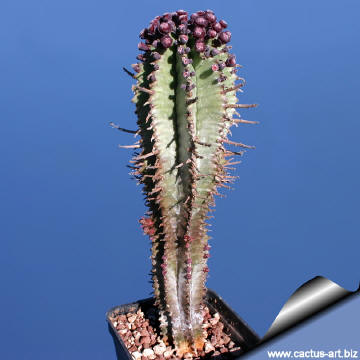 |
 |
|
. |
 |
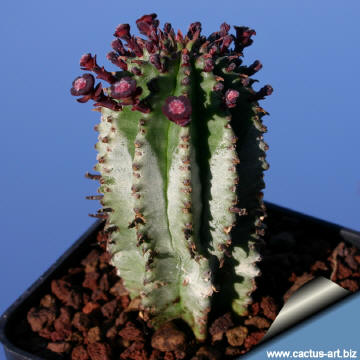 |
|
. |
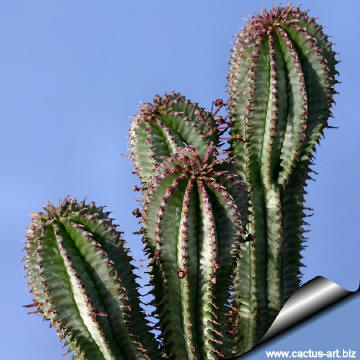 |
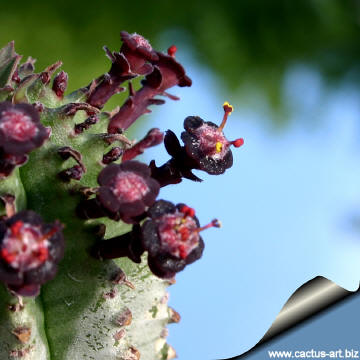 |
|
. |
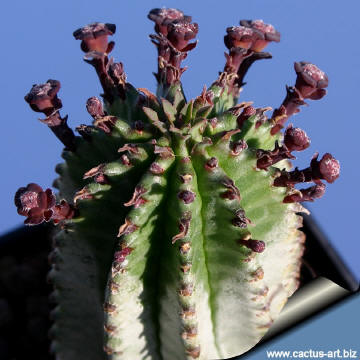 |
 |
|


Advertising
|
|
|
|
|
Family: Euphorbiaceae
Scientific name: Euphorbia submammillaris A.
Berger ex Pax
In: Sukk. Euphorb., 95, 1907
Description based on plants in cultivation of unknown origin.
Origin:
Unknown origin (Supposed from wild plants found in South Africa, Cape
Province)
Conservation status: Listed in
CITES appendix 2.
Synonyms:
- Euphorbia cereiformis var.
submamillaris A. Berger 1902
Possibly a form of E.
fimbriata.
Etymology: The specific epithet 'submammillaris'
comes from the Latin
'sub-',
meaning 'almost, more or less'; and for the similarity to
Euphorbia mammillaris.
|
|
Description: Perennial dwarf succulent shrub which may forms a dense
'cushion' of closely packed columns with a few spines. The clumps can be
over 50 cm in diameter.
The plant found in cultivation and labelled E.
submammillaris are indeed very variable and of doubtful origin.
Often the names “mammillaris” and “submammillaris”
are used indifferently to indicate the same identical plants. and also
in collection a number of plant called "submammillaris"
will surely belongs to other different taxa or are hybrids of uncertain
origin.
The cultivated “form” described in this page is a quite different
from the common E, mammillaris.
(If you have a more exact classification for this plant, please let know
your comments)
Stems: Cylindrical, about
1,5-4,5 (or more) cm in diameter, 10-20 cm long, apex hemispherical,.
Green to pale green, eventually covered by a chalky white bloom,
but turning pink near the tops in the cold of winter.
Ribs: 7-10, deeply grooved between with shallow tubercles
separated by horrizontal grooves up to 4 mm apart.
Spines (Sterile peduncles): None or few scattered, solitary, 1-2 cm long
with 3-4 small bracts.
Flowers: Dioecious, deep maroon-purple. Cyathia 5 mm Ř, solitary
in clusters near the brances tips, peduncles up to 4 mm long, with 6-6
purplish bract up to 3 mm long.
Blooming season: Winter or spring (depending on growing conditions)
|
|
|
|
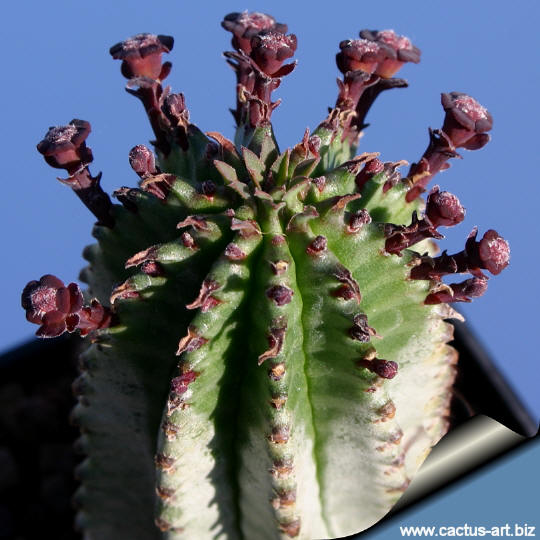
The deep maroon flowers appears in winter or spring.
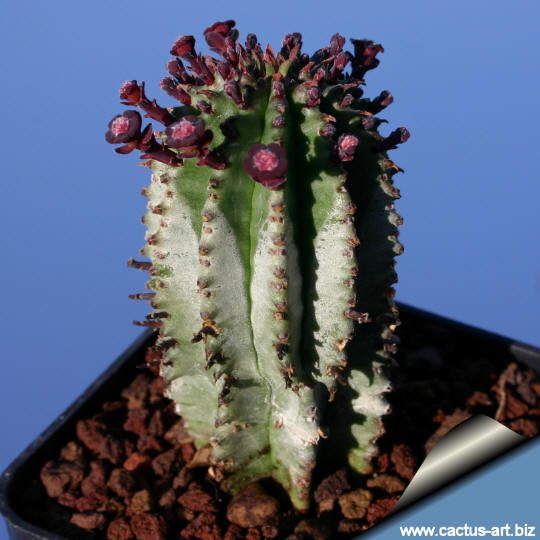
Attractive Euphorbia will form colonies of small, closely packed columns with a few
spines.
Cultivation:
An easy-to-grow plant for pot culture. It grows well in a very draining
mineral potting substrate, but it isn't picky about soil. It can be
watered during the growing season, and enjoys average feeding and
watering. When dormant in winter, keep it totally dry at at around 4°C.
They need a lot of light to keep their compact growth-form. The plants
that are not kept in full sun grow faster, but become untidy and may
need support as they get larger. But one gets best colour if grown in
full sun, where the chalk white stem of this low-growing clumping
columnar plant has the best colour. It is also a prolific flowerer and
makes a spectacular specimen.
Propagation: It is propagated by cuttings or
seeds. Its branches and offsets are readily available. If you remove an
offset, remember to let it dry for a week or so, letting the wound heal
(cuttings planted too soon easily rot before they can grow roots). It is
better to wash the cut to remove the latex. The seed can be sown just
under the surface in normal seedling trays, in a sandy seed mix.
Germination usually occurs within 1 - 3 weeks.
Warning: As with all other Euphorbias, when a plant get
damaged it exudes a thick white milky sap known as latex. This latex is
poisonous and may irritate skin, so pay extreme attention not to get
any in your eyes or mouth.
Cultivated plants must be handled carefully.
|
|